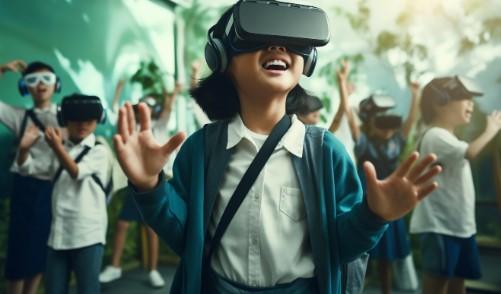Gamified Learning: The Future of Fun and Effective Education

The digital era has also influenced the gradual extinction of traditional methods of learning to keep up with the modern tech-savvy and smart learners. One of the most attractive things happening in education is Gamified Learning, a playful approach to using non-game elements demonstrating similar aspects of games and tech-based learning together. Gamified Learning is changing knowledge and skills acquisition, ability, and motivation through and in the educational process, from schools to big companies.
What Is Gamified Learning?
The word "gamification" refers to the application of game design elements such as points, badges, leaderboards, and challenges to non-game environments including education and professional training. The purpose of such application is to create an atmosphere of fun, interactivity, and reward in learning. Gamified Learning is very much game-like in its nature, so that learners' active engagement is guaranteed throughout their entire learning journey.
This idea does not suggest that the education process should be entirely replaced by a game; rather it allows the application of gaming strategies to uplift the learning experience. People who are doing their work or studying receive points for their accomplishment according to each step they master; hence, they experience the feeling of success along the way — something that actuates the learner's desire and keeps them going.
The Power of Gamified Learning
The main reason Gamified Learning works lies in its ability to make learning fun and somehow engaging. Unlike traditional teaching practices that rely mostly on lectures and rote memorization, gamification has a much broader psychological appeal as it rewards every effort made and every bit of progress achieved. This not only motivates the learner but also at the same time help them keep the knowledge for a longer period of time.
One-much research has demonstrated that students who learn through gamified environments are less likely to drop out, attend the classes actively, and not only get a good but even above average mark in the tests. The feedback is instant in gamified platforms making it easier for those retraining or learning new skills to know their strengths and weaknesses immediately thus speeding up the process of improvement.
Core Elements of Gamified Learning
-
Points and Rewards:
Learners rack up points by completing lessons or activities. These points usually correspond to levels or virtual rewards, offering instant gratification.
-
Badges and Achievements:
Digital badges are markers for hitting goals or being skilled in a certain area, which in turn boosts one's confidence and power.
-
Leaderboards:
Competition-within-their-own-groups motivates learners to do better and even more so to stay hooked on the content.
-
Levels and Progress Bars:
Visual tracking of progress shows learners how far they've got and pushes them to learn more.
-
Challenges and Quests:
Quests change lessons into missions thus providing learners with a sense of direction and thrill from realizing each ambition.
Benefits of Gamified Learning
1. Increases Motivation
Gamification gives immediate feedback and awards that can be seen, which compliments learners' motivation. When they can observe their progress in measurable terms, they are more likely to engage in it.
2. Improves Retention and Understanding
Memory retention is better when the methods are active and hands-on. The students will remember more if they are emotionally engaged in the process.
3. Encourages Healthy Competition
Leaderboards and challenges will not only encourage the students to overshadow themselves but also support teamwork in group competitions.
4. Promotes Self-Paced Learning
Gamified Learning enables learners to go through the content at their own pace making it suitable for all types and speeds of learners.
5. Builds Problem-Solving Skills
The use of games in education encourages the development of the mindset of critical thinking, strategic decision-making, and the application of creativity, which is the core competence for the success of both academic and professional careers.
Examples of Gamified Learning in Action
1. Duolingo – Learning Languages with Fun:
Duolingo, a gamified-learning app, is a top-tier example of Gamified Learning in action. It makes use of the game-like aspects of the learning process, such as points and levels, to keep learning fun and engaging. To the delight of millions of worldwide users, a language is won every day through their approach to learning.
2. Kahoot – Interactive Classroom Learning:
Kahoot gives teachers the opportunity to create live quizzes in which students compete to answer questions correctly. The consequence of such a practice is more interaction, thrill, and long-lasting learning.
3. BYJU’S and Edmodo – Gamified Education Platforms:
These educational platforms use a variety of engaging tools such as interactive videos, quizzes, and leaderboards to increase students' enthusiasm and participation thereby making learning more dynamic and interesting for every age group.
Gamified Learning in Corporate Training
Moreover, besides education, Gamified Learning is rapidly going to have a great impact on the corporate sector. Companies are implementing gamified training to enhance employee engagement and productivity. Learning new skills becomes more fun and effective for the organization by making training sessions into interactive challenges or simulations.
For example, a sales team may earn badges for achieving the set goals or complete virtual missions to learn new products. Not only does this lead to increased performance but also the company acquires and retains a culture of healthy competition and continuous learning that becomes its hallmark.
Challenges of Gamified Learning
The benefits of Gamified Learning are many, but it also has its challenges. A badly designed gamification that is not focused and directed to specific learning goals may end up focusing solely on the fun aspect of the game rather than the actual learning. If students become too competitive or score-driven, the educational value of the activity could be hindered.
Thus, the teacher and the trainees need to keep aligning gamification with their specific learning goals. The learners' knowledge development needs to be the center of focus with the use of game elements to enhance that but not to replace it.
The Future of Gamified Learning
In the long run, it seems we will not be able to avoid using Gamified Learning, since it has so much potential. As technology gets better, the adoption of VR, AI, and AR will make learning even more immersive. Just imagine the scenario where the medical students are performing surgeries using virtual patients or the engineers are solving environmental problems via interactive missions.
Gamified Learning is now more accessible than ever before thanks to mobile apps, e-learning platforms, and AI-driven personalization. The use of Gamified Learning is no longer confined to the classroom; it is gradually becoming a part of the way we learn, work, and grow in the future. click here
Conclusion
Gamified Learning has taken education by storm, making teachers into adventure guides, tests into challenges, and learning into a thrilling journey! Besides the increased engagement and retention, it also boosts learners’ self-esteem and facilitates the acquisition of essential life skills along with development that lasts for a lifetime.
The adoption of Gamified Learning across schools, colleges, and industries is a clear indicator that this wave is here to last. The future of learning is fun, interactive, and rewarding— gamification is at the forefront of this transformation.



